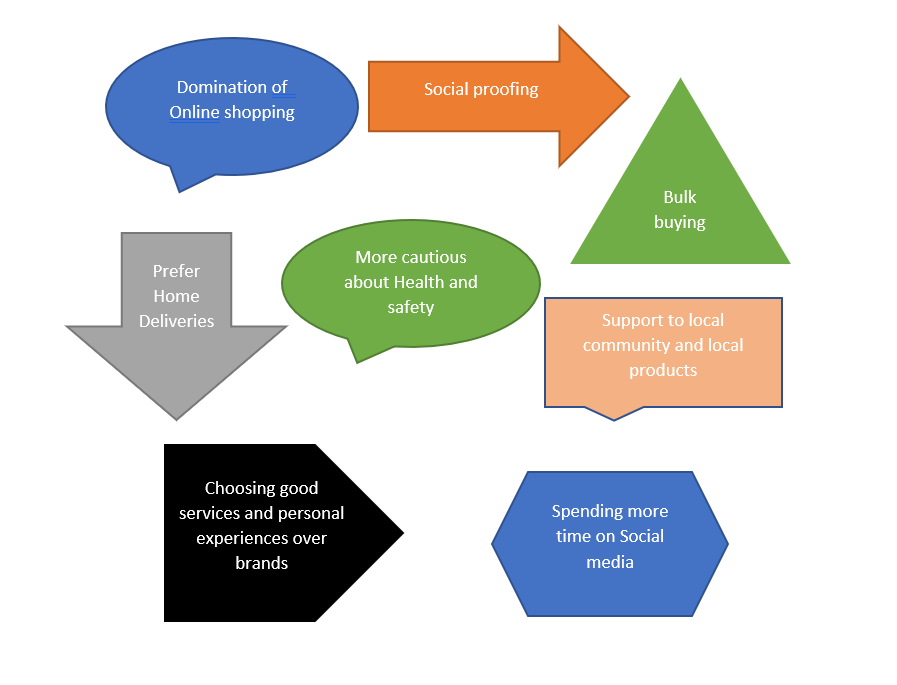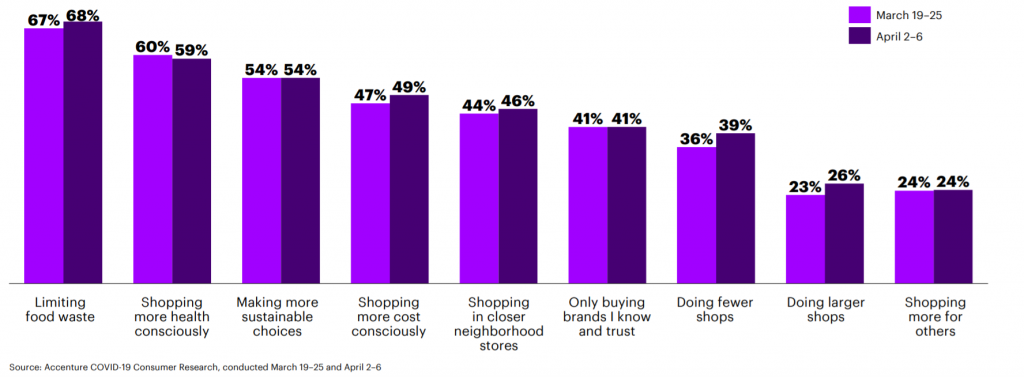
Customers are critical for any business, the earlier you understand your customers the more effectively you can react to their needs in the future. Abraham Lincoln famously said, “The best way to predict the future is to create it.”
During this lockdown, I have read lots of reports, based on surveys and analysis conducted by various marketing research companies, which try and identify new behaviour changes of customers. Here I’m going to share some of these findings. As well as discussing some of the ways in which you can use CRO to ensure you are embracing this throughout your website and digital assets to maximise your ROI.
Big Changes
The COVID-19 global pandemic is one of the defining events of 2020. Which will have implications that last long on global customer behaviour. What to buy? How to buy? Where to buy? We can easily notice changes in these three customer approaches.
Consumer behaviour has been forced to immediately change – and change on a massive scale. People under the lockdown situation who cannot go out to their local shops (at all, or at least less frequently), now move towards online shopping.
Concerns about the availability of goods originally caused panic, bulk-buying of items. Financial uncertainty, and the prospect of a severe and long-term recession, has led to an impact on consumer outlook, perceptions, and behaviours.

Source- Accenture Covid-19 customer behaviour research
Customer online behaviours changes?
With restricted social life, we can clearly see from the graph above lots of adjustments in people’s behaviour. From fear to action, freedom to safety, cure to precautions, outdoor to indoor, from offline to online. Also junk food to home-cooked meals, luxury items to essentials, imported products to local products, from physical shopping to home-deliveries…
There is no doubt that people are spending more time online to read news content too and (according a March report market research company Appinio) traffic on news sites have increased by 48%.
Loss of community touch forces people to spend 41% more time on social apps like Facebook, Twitter, Whatsapp, Zoom, Hangouts and many more. Places of entertainment such as movie theatres and theme parks have been replaced by online movie streaming sites like Netflix which is showing a 45% increase in traffic in month of March.
Online games show a sharp increase of 29%. Physical gyms have been replaced by online activity classes or people buying the required equipment to practice them at home; and people are also downloading fitness apps 40% more than before (according to Appannie).
Students are also spending more time online exploring new sources of knowledge such as online videos and educational sites. One more new behaviour change we have noticed recently, customers are now spending money more on essentials than luxury.
Domination of online shopping
People have been gradually moving from offline shopping to online, even before COVID-19, and it looks like the behaviour will not disappear when the pandemic is over (according to this Accenture COVID-19 customer behaviour research). If anything this trend will accelerate.
This will of course have a very big impact on the whole retail and eCommerce industry. This we can put down to fear of COVID-19 infection always being present. Instead of going to shopping centres, many shoppers may choose to buy their products online.
Online deliveries & pick up from store trends increasing
There is a prediction that not only the buy-online culture is going to continue to flourish but also online deliveries and pick up from store will likely be a big part of our lives for the long term.
Not only retailers are going online from offline but restaurants, pubs and bars have also been preparing themselves to enter a world of online ecommerce by starting online deliveries. This can also be seen according to latest data by Statista there is significant increase in delivery services like Just Eat (16%), Deliveroo (7%), Uber Eats of (8%) in recent times.
Digital delivery has become a necessity for most customers who are confined at home. Adoption has grown strongly, even among the most “digitally resistant” customers.
Those who placed an online ship-to-home order in the past month indicated it was their first time ever or first time in the last six months doing so. About one-third of click-and-collect users were new or ‘new lately’.
Customers opting for local products
This lockdown also greatly changed our impact on our social behaviour, it helped to bring back local community culture. In a study conducted by Accenture and various other market research companies, we can see 44-46% people more inclined to buy local products. People want to try and support their local businesses over big international brands. Even if they are buying products in a supermarket, they seem to be preferring those which come from local sources.
Maximise your online assets
Conversion rate optimisation can be your greatest ally when it comes to navigating your way around providing the experience and products that these new prospective customers are looking for – without forgetting your previous loyal customers of course.
Optimising your customers’ user experience using AB testing and personalisation/targeting techniques and tools is key. Here are a few ideas…
Personalised experiences
Personalisation is a critical component of customer experience. In this lockdown period customers have had to deal with the scarcity of lots of products, for example hand-sanitiser, face masks, toilet rolls, flour and much more.
Out of stock signs are very common on various retail sites which is great to see.
Keeping people up to date with changes helps ease anxiety and increases consumer and brand trust.
Consumers are also always happy to see a product of their interest and do not want to spend time searching for them. So ensuring these are presented ‘front and centre’ when they visit your site is important.
Businesses will have to find ways to create a hyper-personalised environment. That is why many companies are looking for ways to collect customer data to better understand where to start and how to personalise correctly.
One common method is gathering feedback from customers with custom quizzes or onsite surveys. This can done with Webtrends Optimize allowing marketeers to personalise data collection forms to the needs of specific target audiences.
Social Proof & Product Recommendations
People always have a desire to fit in with the rest of society which affects our lives in a variety of ways, including our purchasing behaviour. Ask yourself, have you ever purchased a product after a recommendation from somebody else? If you have, you have been influenced by what we call ‘social proof’.
Webtrends Optimize adapted to this new culture some time ago and we are very happy to support all our existing and prospective clients to understand how they can use this tool effectively. Our social proof and product recommendation engines come as standard features, at no additional cost.
We envisage Social Proofing and Product Recommendations, not only now to be about ‘how many people have also bought the product’ or what products are ‘competitively priced with what you’re currently viewing’. But also, about local produce where was it sourced. Is it eco-friendly? Are people happy with delivery? As well as recommendations becoming more locally focused.
For example, local produce companies now have their own websites pre covid-19 there was less emphasis on online presence. However local businesses have been forced to take the online route a little more seriously. Here are a few ways in which I think Social Proofing and Recommendations could be tailored for them:
Social Proofing, Statements to helps consumers such as: ‘x’ number other people within your community also have purchased this item. Or with Product Recommendations ‘here are 4 similar ales that have been produced 5 miles from you’. The power of local community and local responsibility is growing.
Customers want a good experience as much as the product
If you think why you yourself return to a website to buy things (or even physical shops) it can be as much about the experience as the products. Yes, price comes into play, and other factors, but the importance of the user experience cannot be underestimated. If it is easy to find what you want and purchase it and the price is in the ballpark, why wouldn’t you keep coming back?
Approaches may need to change too. According to one survey (conducted by First insight) we can see lot of behaviour changes in younger consumers especially, who may not want to buy their own car, but like to pay a monthly fee for access to a shared car. The same goes for services like streaming media, vacation rentals and food delivery.
New ideas will be needed, and businesses may invest in virtual experiences like in-store demonstrations that can be viewed online, or virtual salespeople who can engage with shoppers.
As with everything to do with user experience, testing is incredibly important. What works for one brand/business/website/product range may not work for another. Through Multivariate and AB testing you can ensure that the experience you deliver on your website is right for your customers.
In conclusion
Consumers will return to stores, malls, and social gathering places after the crisis passes. However, the crisis will make retailers look for more ways to deliver virtual experiences, and to interact with shoppers online, rather than focusing primarily on drawing crowds to their stores.
In these uncertain times, there are enormous possibilities and we just need to take a different approach, and a positive attitude. The way companies deal with their customers, their employees, and community in a crisis, hopefully will leave a positive impact in customers’ minds.
Your customers are trying to adapt to new norms of life and shifting their behaviour as a result. As a company, you are also facing the same type of uncertainty, while trying to support your customers’ needs and your own.
If you have an online business and need any help understanding the impact of COVID-19 and want to improve your conversion rate then Webtrends Optimize has teams of specialists who can help you with various ways.
If you have any questions or would like to chat with us about how we could help, Please do get in touch.

